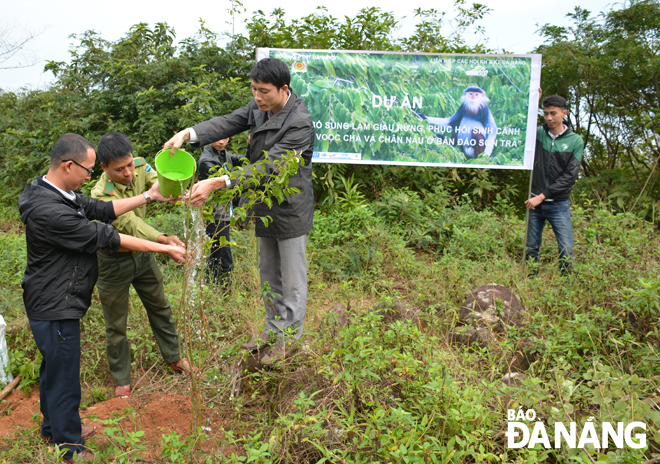Da Nang man deep concerned with biodiversity conservation
Over the past decade, Mr. Nguyen Xuan Vi has been struggling to find solutions to preserve and develop biodiversity not only in Da Nang but also in other provinces and cities across the country.
 |
| Mr. Nguyen Xuan Vi (third, left) implements the project "Planting trees to enrich the forest, restoring habitat for red-shanked douc langurs in Son Tra Peninsula". |
After graduation from the Faculty of Biology and Environment at the Da Nang University of Education in 2006, Vi worked at the Kon Ka Kinh National Park in Gia Lai Province.
With a special love for nature since his childhood, especially during his university years when he experienced and discovered the beauty of the Son Tra Peninsula, Vi wanted to do something to preserve and promote biodiversity development, especially protecting red-shanked douc langurs - the ‘Queen’ of the primate species.
In early 2012, he established the Green Viet Biodiversity Conservation Center (GreenViet) under the Da Nang Union of Science and Technology Associations, headquartered at Thanh Vinh 1 Street, Tho Quang Ward, Son Tra District.
For the purpose of researching, propagating and disseminating knowledge and information related to biodiversity conservation and environmental protection in the community, especially students and young people, for more than 10 years, Vi and his colleagues at GreenViet have organised hundreds of communication sessions at educational establishments, communes, wards, and agencies in the city.
Also, they have provided financial and technical support for a number of clubs, teams, and groups at universities to implement educational programmes and raise public awareness of environmental protection.
Besides, GreenViet has implemented a mobile library project in an ecological space at the city-based Hermann Gmeiner School at a total cost of nearly VND500 million.
It has coordinated with the Green Hero Club to carry out experiential and educational activities for students in local education subject according to the 2018 general education programme with a budget of VND100 million.
Additionally, it has implemented a communication project to protect red-shanked douc langurs through images on billboards placed at bus stops citywide.
To have operating funds, Vi has actively made every effort to mobilise nearly VND10 billion every year from domestic and foreign environmental protection projects.
GreenViet uses a very small part of the funding source to pay salaries for 20 employees, whilst the rest is spent on carrying out communication and education activities to raise community awareness about protecting forest and marine ecosystems, and supporting localities in biodiversity conservation work.
Vi said that the ecological environment is very important for the development not only of animals and plants but also of humans. In recent times, some localities have impacted the ecological environment, flora and fauna because of economic development. This narrows the habitat, affecting the safety of some rare animals and plants.
Therefore, GreenViet's highest mission is to help the community form a nature-friendly lifestyle, in which, disseminating knowledge about biodiversity through experiential education for the young generation is an appropriate tool, means and directions to carry out that mission.
Following that success, in 2016, Vi continued to establish the Nature Experience Education Center under GreenViet to serve students and tourists to free of charge study and visit the biodiversity of the Son Tra Peninsula.
According to statistics released by the Nature Experience Education Center, the centre welcomes an average of about 2,000 students and tourists every year.
Truong Thi Ngoc Anh, a pupil at the Thai Phien Senior High School, shared that during her trip with her family, she saw wild animals and visited where they live. Thanks to such field trip, she understood and loved wild animals better.
Meanwhile, Mrs. Nguyen Thi My Linh, a mother of a pupil of the Do Dang Tuyen Junior High School, highlighted the meaningfulness and usefulness of the trip. She remarked through the trip, children not only gained knowledge but also practiced social and recognition skills in a real-life environment.
The establishment of the Nature Experience Education Center not only affirms the role of the natural ecosystem of the Son Tra peninsula in the field of education but also contributes to promoting environmentally- friendly behaviour with nature in the community as well as making specific contributions to conservation work on the peninsula through priority conservation activities. Included are planting trees to restore habitat for red-shanked douc langurs, collecting waste to avoid spreading diseases to wild animals, changing improper behaviours when visiting the peninsula, and especially preserving the natural ecosystem against great pressures of development activities.
It can be said that this is not only an effect but also an important factor to carry out the conservation and development of biodiversity in Da Nang in general and the Son Tra Peninsula in particular.
Every year, Mr. Vi and his colleagues coordinate with the Son Tra Peninsula Management Board to periodically organise educational activities to raise awareness about environmental protection in Son Tra forests and on local beaches.
Since 2020, through mobilisation and connection of resources, Mr. Vi and GreenViet have supported more than 30 thousand trees of all kinds to plant citywide.
Most recently, GreenViet has worked with the Executive Committee of the Da Nang University of Education to carry out a project to increase awareness of protecting the red-shanked douc langurs in Da Nang through a media campaign called "Dances of red-shanked douc langurs". The project has created a strong spread in the community, especially among students.
Not only in Da Nang, Vi and his colleagues have visited many localities such as Quang Nam, Gia Lai, Dak Lak and Ho Chi Minh City to implement biodiversity research and conservation projects.
The actions of GreenViet as well as Mr. Nguyen Xuan Vi have expanded and connected habitats for 3 species of douc langurs in the Central Viet Nam and Central Highlands regions in 3 aspects of gathering conservation areas; forest planting and restoration; and connecting fragmented forest areas.
Reporting by NHAT LINH - Translating by M.DUNG